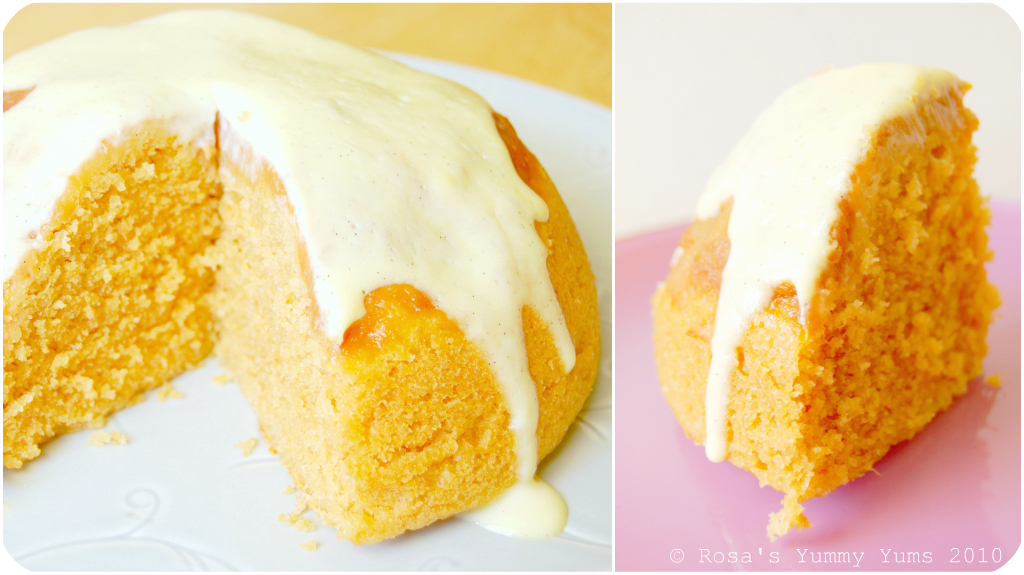
The April 2010 Daring Bakers’ challenge was hosted by Esther of "The Lilac Kitchen". She challenged everyone to make a traditional British pudding using, if possible, a very traditional British ingredient: suet.
~~~~~~~~~~~~~~~~~~~~~~~

- Black or white pudding which are both sausages. Black pudding is made with blood (English version of "Boudin"). White pudding is very similar to black pudding, but it does not include blood (English version of "Boudin Blanc").
- A generic word for dessert.
- Any sweet or savory dish cooked in a pudding bowl or pudding cloth and steamed, boiled or sometimes baked.
- An endearment i.e., "How are you today my pudding?".
English puddings have had a great reputation since the 17th century. One French visitor, the protestant exile François Maximilien Mission who came to England at the end of the 17th century wrote a very interesting description in his memoirs in which he was very lyrical about the unexpectedness and variety of English puddings (" Mémoires et observations faites par un voyageur en Angleterre" published in 1698). "They bake them in an oven, they boil them with meat, they make them fifty several ways: BL ESSED BE THAT WHO INVENTED PUDDING, for it is a manna that hits the palates of all sorts of people."
There are many different sweet or savory puddings (the possibilities are nearly endless), but all are made with the same basic ingredients such as flour, milk, eggs, butter or suet (mostly suet), sugar and fresh or dried fruits (if it is the sweet version) and meat or marrow (if it is the savory version). This comforting and homely dish adapts itself perfectly to the seasons and is extremely versatile. That's surely the reason why it has b een cherished by legions of people over the centuries.
Unfortunately, this gorgeous speciality has also become the first victim of mass catering and manufacture. It's reputation has suffered from the bad image given by the unappetizing, bad quality and industrially made puddings which have been commercialized in mass in supermarkets and served in chain restaurants since decades (that's how British food got most of it's bad reputation.). It is very saddening to see th at it's reputation has been dragged through mud and that it is rare nowadays to fin d somebody who actually makes that treat from scratch. Real puddings are so unique as well as delightful and have nothing to do with the bland, stuffy and extremely unhealthy versions that you can find in stores. Nothing compares to a luscious homemade pudding. Not only is it made with love, but also with a great deal of respect for the culinary traditions of Britain!
~~~~~~~~~~~~~~~~~~~~~~
Since I have officially become one of the biggest procrastinator (well, I'm also a chicken and "stress bag" LOL) on the planet, it is now in my habit to wait until the very last minute to gather up enough strength, courage and energy in order to get my sorry ass off my chair and into the kitchen! That is why you'll never fi nd my Daring Bakers' post up one minute after midnight anymore, but rather more than 20h hours after the official release date...
Anyway, when I had decided that it was about time for me to get started and once I could not have a lame excuse not to raise hell in the kitchen a ny longer, things got rolling and moving fast. My "Suet Pudding" dough was made in a zip and placed in it's personal "sweat lodge" for a few hours!Did you know that I had been meaning to make pudding since a very long time, but for no real reason the steaming process always daunted me a little? Not that I never steamed any food in my life, though. It was just one of th ose scares that had no reason for being. I mean, I have an electric steamer and a Chinese steamer which I very much use, but have not been able to make pudding until now. Go find out why... Yes, even the most daring of us bakers can have doubts and fear!
As we were free to choose the recipe that we w ere going to make, I decided to make the "My Fair Lady Pudding" which is a sponge type suet pudding containing lemon rind. I added some rhubarb (mixed with light brown sugar and a dash cinnamon) at the bottom and served it with "Custard Sauce".
This "Suet Pudding" is easy as Sunday morning and require no other skills than being incredibly patient (it has to get steamed for about 3 hours) and, although it might look not too attractive (and photogenic), boy, this dessert is to die for. The texture of that pudding is so smooth, fluffy and moist. Taste-wise it is really pleasant as it has a refreshing lemony aroma, an interesting nutty flavor (thanks to the suet used) and is not overly sweet. I really recommend you to serve it with custard sauce as it adds a dimension more to the pudding (it goes from delicious to lipsmackingly scrumptious). Heaven in a bowl!
I wish to thanks Esther for having chosen that great British treat and for making me realize there's no reason to fear pudding. I will certainly make this goodie on a regular basis now!

Equipment required:
• 2 pint (1 litre) pudding bowl or steam-able containers to contain a similar amount they should be higher rather than wide and lowTraditional pudding bowl
• Steamer or large pan, ideally with a steaming stand, upturned plate or crumpled up piece of kitchen foil
• Mixing bowl
• Spoon
• Measuring cups or scales
• Foil or grease proof paper to cover the bowl
• String
Ingredients:
100g (4 Oz) All-purpose flour
1/4 Tsp Sea salt
1.5 Tsp Baking powder
100g (4Oz) Breadcrumbs
75g (3 Oz) Caster sugar
75g (3 Oz) Shredded suet or suet substitute (i.e., Vegetable Suet, Crisco, Lard)
1 Large egg
6 to 8 Tbs Cold milk
Method:
1. Sift flour, salt and baking powder into bowl.
2. Add breadcrumbs, sugar and suet.
3. Mix to a soft batter with beaten egg and milk.
4. Turn into a buttered 1 litre (2 pints) pudding basin and cover securely with buttered greaseproof paper or aluminum foil.
5. Steam steadily for 2.5 to 3 hours.
6. Turn out onto warm plate.

Variants:
Add 75g/ 3oz currants and 25g/1 oz of mixed chopped peel with the sugar.
Syrup or Treacle or Marmelade Pudding
Put 2 Tablespoons of golden syrup, treacle or marmalade at the bottom of the bowl before adding pudding mix.
My Fair Lady Pudding
Add finely grated rind of 1 medium orange or lemon with the sugar.
Ginger Pudding
Replace the sugar with 100g/4oz of treacle, and add 1/2 tsp ground ginger.
Serving suggestions:
Serve with sweet sauce to taste such as custard, caramel or a sweetened fruit sauce.
Remarks:
The easiest way to steam a pudding is in a dedicated steamer as the water is kept away from the pudding so it can’t boil over. If, however, you don’t have a steamer use a pan large enough to easily fit the bowl you are cooking.
Don’t fill the water more than about a third of the way up the bowl or it may boil over and into the bowl. Keep an eye and top up as needed with boiling water.
You need to lift the bowl off the bottom of the pan. This can be done with a steamer stand, an upturned plate or even crumpled up kitchen foil — anything that can stand being in boiling water and lifts the bowl off the bottom of the pan will work.
Make sure you have a well-fitted lid on the pan as you want the steam to cook the pudding not to boil off.

~~~~~~~~~~~~~~~~~~~~~~~
Etant donné la longueur du texte original, je n'ai malheureusement pas pu faire une traduction française de ce billet et je m'en excuse auprès de tous mes amis lecteurs et blogueurs francophones!
C'est pourquoi je vous suggère de vous rendre sur le blog mentionné ci-dessous. Vous y trouverez cette recette en version française.
Chez Isa de "Les Gourmandises d'Isa" (Canada)
Chez Vibi de "La Casserole Carrée" (Canada)

0 comments:
Post a Comment